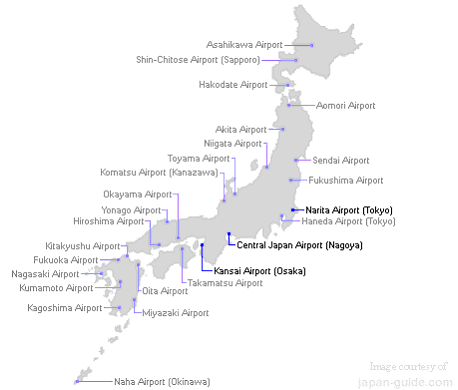Arriving in Japan
Before departing for Japan, it is important that you understand Japan’s immigration laws. If you do not already have a visa arranged, visit the Ministry of Foreign Affairs website to determine what kind of visa you need and how to go about obtaining one. Japan has strict immigration policies and it is highly recommended that you have your visa status in order before entering the country.
After making the decision to live and work in Japan and booking your flight, it is time to think about what to do once you get on the ground. The flight to Japan can be long and exhausting, and clearing customs and finding transportation to your destination may seem daunting. Unfortunately, you may be faced with a long train, bus, or car ride, as some airports will not be conveniently located for you. To avoid frustration and confusion, do some planning ahead of time to determine how you will get from the airport to your final destination.
Below is a map of the airports currently operating in Japan. The three largest airports are in bold and are the main hubs for international flights, especially to Western countries.

The first thing you must do once you arrive is to go through Japan immigration, followed by customs. Despite all of the detailed rules regarding customs, you need not be concerned unless you are carrying unusual cargo, or cargo of considerable size or quantity. Regular travelers should remember to fill out the customs claim form that will be passed out on the plane before arrival, and have their passport ready. Mike Newman’s Narita Layover Page provides tips on the inner workings of Narita Airport and what to do in the general Narita area. Note that this page is no longer regularly updated, so be sure to double-check any information you find here.
After passing through immigration and customs, you are ready to tackle the task of getting to your desired location. Narita and Kansai International Airports, as well as Haneda (used more for domestic flights), have a train line that connects to the system of mass transit located within the city. These trains are usually the best option for anyone flying into Narita or Kansai. Be aware that although some airports like Nagoya offer train service, they may be private lines and therefore do not accept JR Railpass. Another option is to take one of the buses that run into the city (such as the Friendly Airport Limousine). Tickets are available for purchase at counters in the arrivals area. If you fly into a more isolated airport without train service, prearrange some other type of transportation or, if possible, plot your bus route in advance.
To determine your train route ahead of time, try using Jorudan’s Train Route Finder. This site will provide you with multiple results for trains you can take. If you are in a hurry, chose the fastest route. If you will have heavy luggage, select the route with the least transfers.
Most of the information on the Internet is focused on Narita, Japan’s busiest airport. Here are some links to help you plan your transportation from the airport:
For more information on when to travel, airlines, Japanese airports and their facilities, please visit Japan-guide.com’s International Air Travel Page.
- Career Tools
- Columns

